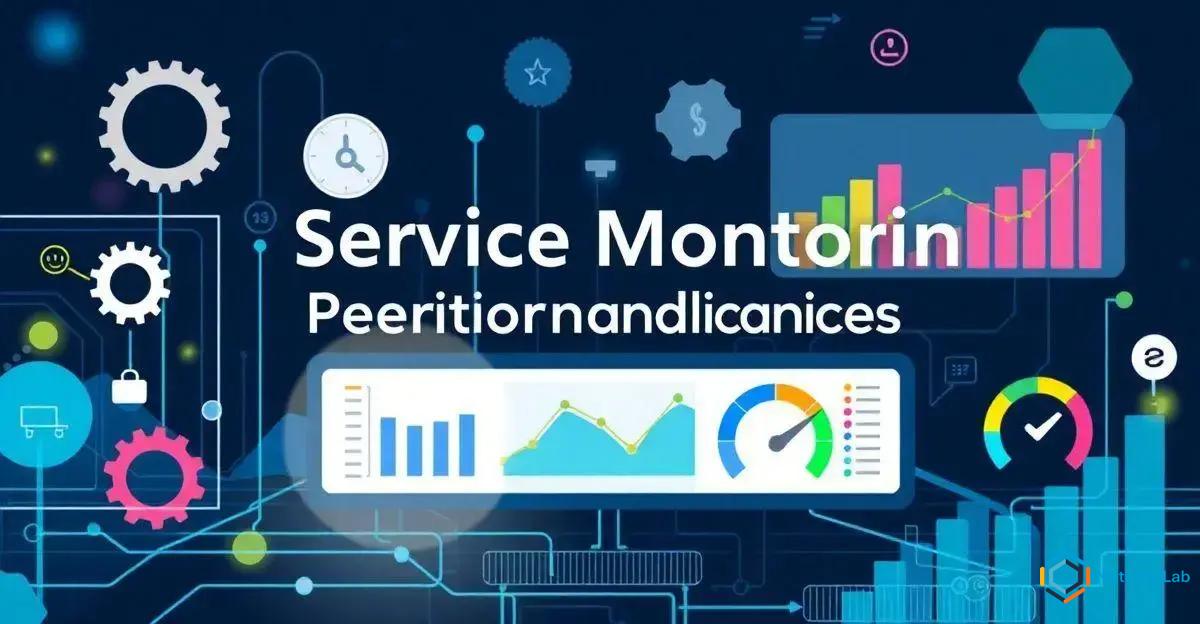The Service Monitoring Maturity Model (SMMM) is a strategic framework designed to enhance service performance through improved monitoring practices, focusing on key performance indicators (KPIs) such as response time and uptime, while integrating technology and fostering cultural shifts to align monitoring with business objectives, ultimately driving operational efficiency and customer satisfaction.
In today’s fast-paced business environment, effective service monitoring is crucial for maintaining competitive advantage. By leveraging the Service Monitoring Maturity Model (SMMM), organizations can systematically enhance their service performance through the use of well-defined performance indicators. Understanding the role of SMMM in service monitoring and identifying the key performance indicators can significantly improve operational efficiency and customer satisfaction.
Understanding SMMM and Its Importance in Service Monitoring

Understanding SMMM and Its Importance in Service Monitoring
The Service Monitoring Maturity Model (SMMM) serves as a comprehensive framework designed to assess and enhance the maturity of service monitoring practices within an organization. This model is integral to ensuring that service monitoring processes are not only effective but also aligned with the strategic objectives of the business. At its core, SMMM provides a structured approach to evaluate current monitoring capabilities, identify gaps, and implement improvements that lead to optimized service delivery.
SMMM operates on several maturity levels, each representing a different stage of development in service monitoring practices. These levels range from initial, where monitoring is ad-hoc and reactive, to optimized, where monitoring is proactive, predictive, and fully integrated into business processes. By progressing through these maturity levels, organizations can transition from merely reacting to service issues to anticipating and preventing them, thereby enhancing overall service quality.
Key Aspects of SMMM
One of the key aspects of SMMM is its focus on performance indicators. These indicators are metrics used to measure the effectiveness and efficiency of service monitoring activities. By identifying and tracking relevant performance indicators, organizations can gain valuable insights into their service operations, enabling data-driven decision-making and continuous improvement. For instance, metrics such as response time, uptime, and customer satisfaction can provide a clear picture of service performance and highlight areas for enhancement.
Moreover, the implementation of SMMM fosters a culture of continuous improvement and accountability within the organization. It encourages cross-functional collaboration, as different departments work together to achieve common monitoring goals. This collaborative approach not only improves service monitoring practices but also aligns them with broader business objectives, ensuring that monitoring efforts contribute to the overall success of the organization.
In conclusion, understanding the Service Monitoring Maturity Model and its importance is essential for any organization seeking to improve its service monitoring capabilities. By adopting SMMM, businesses can systematically enhance their monitoring practices, leading to improved service performance, increased customer satisfaction, and a stronger competitive position in the market.
Key Performance Indicators for Effective Service Monitoring

In the realm of service monitoring, Key Performance Indicators (KPIs) are indispensable tools that provide quantifiable measures of performance, allowing organizations to assess the effectiveness of their service delivery processes.
These indicators are critical for identifying areas that require improvement and for tracking progress over time. By selecting the right KPIs, businesses can ensure that their service monitoring efforts are aligned with strategic objectives and are contributing to overall organizational success.
To begin with, one of the most fundamental KPIs in service monitoring is response time. This metric measures the time taken to respond to service incidents or customer inquiries. A shorter response time generally indicates a more efficient service operation, leading to higher customer satisfaction. Organizations should aim to minimize response times by streamlining processes and leveraging automation where possible.
Another crucial KPI is service uptime, which refers to the percentage of time that a service is operational and available to users. High uptime is indicative of reliable service performance and is often a key factor in customer retention. Monitoring uptime allows organizations to identify patterns or recurring issues that may lead to service disruptions, enabling proactive measures to maintain service continuity.
Customer satisfaction
is also a vital KPI that provides insights into the perceived quality of service from the customer’s perspective. This can be measured through surveys, feedback forms, or Net Promoter Scores (NPS). High levels of customer satisfaction are typically associated with effective service monitoring and management practices. By regularly assessing customer satisfaction, organizations can identify areas for improvement and adjust their strategies accordingly.
Additionally, incident resolution time is a KPI that measures the time taken to resolve service issues once they have been identified. Reducing resolution time is essential for minimizing the impact of service disruptions on customers and maintaining a positive service reputation. Organizations can achieve this by implementing efficient incident management processes and ensuring that staff are adequately trained to handle service issues promptly.
Finally, the cost of service delivery is a KPI that evaluates the financial efficiency of service operations. By analyzing this metric, organizations can identify cost-saving opportunities and optimize resource allocation without compromising service quality. This is particularly important in competitive markets where cost efficiency can be a significant differentiator.
In summary, selecting and monitoring the right Key Performance Indicators is essential for effective service monitoring. By focusing on metrics such as response time, uptime, customer satisfaction, incident resolution time, and cost of service delivery, organizations can gain valuable insights into their service performance and drive continuous improvement.
Implementing SMMM for Enhanced Service Performance

The implementation of the Service Monitoring Maturity Model (SMMM) is a strategic initiative that can significantly enhance service performance within an organization.
By adopting this model, businesses can systematically improve their service monitoring practices, leading to more efficient operations and higher levels of customer satisfaction.
The process of implementing SMMM involves several key steps that ensure a structured and effective approach to service monitoring.
Firstly, organizations must conduct a comprehensive assessment of their current service monitoring capabilities.
This involves evaluating existing processes, tools, and technologies to identify strengths and areas for improvement.
By understanding the current state of service monitoring, businesses can establish a baseline from which to measure progress and set realistic goals for advancement through the maturity levels of SMMM.
Once the assessment is complete, the next step is to define a clear roadmap for implementation.
This roadmap should outline the specific actions required to progress through the maturity levels, including the adoption of new technologies, the refinement of processes, and the development of staff competencies.
It is essential that this roadmap is aligned with the organization’s strategic objectives to ensure that service monitoring efforts contribute to broader business goals.
A critical component of implementing SMMM is the selection and integration of appropriate tools and technologies.
These tools should facilitate the automation of monitoring processes, provide real-time insights into service performance, and support data-driven decision-making.
By leveraging advanced technologies, organizations can enhance their ability to detect and respond to service issues promptly, thereby improving overall service reliability and quality.
In addition to technological advancements, the implementation of SMMM requires a cultural shift within the organization.
This involves fostering a culture of continuous improvement and accountability, where staff are encouraged to take ownership of service monitoring activities and contribute to ongoing enhancements.
Training and development programs should be established to equip employees with the necessary skills and knowledge to effectively utilize new tools and processes.
Furthermore, organizations should establish a robust framework for measuring and reporting on service performance.
This includes the regular review of Key Performance Indicators (KPIs) to track progress and identify areas for further improvement.
By maintaining transparency and open communication regarding service performance, organizations can ensure that all stakeholders are informed and engaged in the process of enhancing service monitoring.
In conclusion, implementing the Service Monitoring Maturity Model is a strategic endeavor that requires careful planning and execution.
By conducting a thorough assessment, defining a clear roadmap, integrating advanced technologies, fostering a culture of continuous improvement, and establishing a robust measurement framework, organizations can significantly enhance their service performance and achieve sustained competitive advantage.
In summary, the adoption and implementation of the Service Monitoring Maturity Model (SMMM) present a structured pathway for organizations seeking to enhance their service performance.
By understanding the foundational principles of SMMM and recognizing its importance in service monitoring, businesses can align their monitoring practices with strategic objectives, thereby achieving greater operational efficiency and customer satisfaction.
The identification and tracking of Key Performance Indicators (KPIs) are crucial in this endeavor, as they provide measurable insights into service effectiveness and areas for improvement.
Implementation Considerations
Moreover, the implementation of SMMM necessitates a comprehensive approach that includes technological integration, process refinement, and cultural transformation within the organization.
By embracing these elements, organizations can foster a proactive service monitoring environment that not only addresses current challenges but also anticipates future needs.
Ultimately, the successful implementation of SMMM can lead to enhanced service reliability, improved customer experiences, and a stronger competitive position in the market.
Frequently Asked Questions about SMMM and Service Monitoring
What is the Service Monitoring Maturity Model (SMMM)?
The Service Monitoring Maturity Model (SMMM) is a framework designed to assess and enhance the maturity of service monitoring practices within an organization, ensuring alignment with strategic business objectives.
Why are Key Performance Indicators (KPIs) important in service monitoring?
KPIs are crucial as they provide quantifiable measures of service performance, helping organizations identify areas for improvement and track progress over time to ensure effective service delivery.
How does SMMM improve service performance?
SMMM improves service performance by providing a structured approach to evaluate and enhance monitoring capabilities, facilitating proactive service management and continuous improvement.
What are some common KPIs used in service monitoring?
Common KPIs include response time, service uptime, customer satisfaction, incident resolution time, and cost of service delivery, all of which provide insights into service effectiveness.
What steps are involved in implementing SMMM?
Implementing SMMM involves assessing current capabilities, defining a roadmap, integrating technologies, fostering a culture of improvement, and establishing a measurement framework for service performance.
How can organizations ensure successful SMMM implementation?
Success in SMMM implementation can be achieved through strategic planning, aligning monitoring efforts with business goals, investing in technology and training, and maintaining transparency in performance reporting.

